Mechanism of Electronegativity Heterojunction of Nanometer Amorphous-Boron on Crystalline Silicon: An Overview
Abstract
:1. Introduction: Initiation and History of Boron-Silicon Junctions and Importance of Si-Based Junctions/Diodes in Microelectronics
- There was no explanation as to where the “monolayer of acceptor states” providing “a monolayer of fixed negative charge” originates from;
- It was not explained what made the charge “fixed”.
2. The PureB Process and Characterization of the Boron-Silicon Junction as a Radiation Detector
2.1. The PureB Process and Temperature Effects
2.2. Characterization of the Boron-Silicon Junction as a Radiation Detector
2.2.1. Responsivity
2.2.2. Resolution
2.2.3. Stability
2.2.4. Operational Speed
3. Boron-Silicon Junction Formation Premise Based on ab Initio Modeling
3.1. Local Chemistry of the c-Si/a-B Interfaces
- The Si atoms in the substrates are positioned in an orderly fashion, whereas the B atoms remain disordered;
- There is a certain amount of disordering for the surficial Si atoms at both substrates.
3.2. Electronic Properties of the c-Si/a-B Interfaces
3.3. Band Bending for the Electronegativity Junctions
4. Conclusions
Author Contributions
Funding
Conflicts of Interest
References
- Sarubbi, F.; Nanver, L.K.; Scholtes, T.L. CVD Delta-Doped Boron Surface Layers for Ultra-Shallow Junction Formation. ECS Trans. 2006, 3, 35–44. [Google Scholar] [CrossRef] [Green Version]
- Nanver, L.K.; Sarubbi, F.; Gonda, V.; Popadic, M.; Scholtes, T.L.; de Boer, W.; Buisman, K. Extremely ultrashallow junctions for a high-linearity silicon-on-glass RF varactor-diode technology. Extended Abstracts. In Proceedings of the 2008 8th International Workshop on Junction Technology (IWJT ‘08), Shanghai, China, 15–16 May 2008. [Google Scholar] [CrossRef]
- Sarubbi, F. Characterization of Pure Boron Depositions Integrated in Silicon Diodes for Nanometer-Deep Junction Applications. Ph.D. Thesis, TU Delft Repository, Delft, The Netherlands, 2010. [Google Scholar]
- Sarubbi, F.; Nanver, L.K.; Scholters, L.M. High Effective Gummel Number of CVD Boron Layers in Ultrashallow p+n Diode Configurations. IEEE Trans. Electron. Devices 2010, 57, 1269–1278. [Google Scholar] [CrossRef]
- Nanver, L.K.; Qi, L.; Mohammadi, V.; Mok, K.R.M.; de Boer, W.B.; Golshani, N.; Sammak, A.; Scholtes, T.L.M.; Gottwald, A.; Kroth, U.; et al. Robust UV/VUV/EUV PureB Photodiode Detector Technology With High CMOS Compatibility. IEEE J. Sel. Top. Quantum Electron. 2014, 20, 306–316. [Google Scholar] [CrossRef]
- Nanver, L.K.; Sammak, A.; Mohammadi, V.; Mok, K.R.C.; Qi, L.; Sakic, A.; Golshani, N.; Derakhshandeh, J.; Scholtes, T.M.L.; de Boer, W.B. (Invited) Pure Dopant Deposition of B and Ga for Ultrashallow Junctions in Si-based Devices. ECS Trans. 2012, 49, 25–33. [Google Scholar] [CrossRef] [Green Version]
- Mohammadi, V.; Nihtianov, S. Low-Temperature PureB CVD Technology for CMOS Compatible Photodetectors. Ph.D. Thesis, TU Delft Repository, Delft, The Netherlands, 2016. [Google Scholar] [CrossRef] [Green Version]
- Knežević, T.; Suligoj, T.; Šakić, A.; Nanver, L.K. Modelling of electrical characteristics of ultrashallow pure amorphous boron p+n junctions. In Proceedings of the 35th International Convention MIPRO, Opatija, Croatia, 21–25 May 2012; pp. 36–41. [Google Scholar]
- Qi, L. Interface Properties of Group-III-Element Deposited-Layers Integrated in High-Sensitivity Si Photodiodes. Ph.D Thesis, TU Delft Repository, Delft, The Netherlands, 2016. [Google Scholar] [CrossRef]
- Mohammadi, V.; Nihtianov, S.; Fang, C. A doping-less junction-formation mechanism between n-silicon and an atomically thin boron layer. Sci. Rep. 2017, 7. [Google Scholar] [CrossRef] [Green Version]
- Elsayed, A.; Schulze, J. Characterization of thin Boron layers grown on Silicon utilizing molecular beam epitaxy for ultra-shallow pn-junctions. In Proceedings of the 2018 41st International Convention on Information and Communication Technology, Electronics and Microelectronics (MIPRO), Opatija, Croatia, 21–25 May 2018. [Google Scholar] [CrossRef]
- Thammaiah, S.D.; Hansen, J.L.; Nanver, L.K. Nanometer-Thin Pure B Layers Grown by MBE as Metal Diffusion Barrier on GaN Diodes. In Proceedings of the 2019 China Semiconductor Technology International Conference, (CSTIC), Shanghai, China, 17–18 March 2019. [Google Scholar] [CrossRef]
- McKernan, M.A. Magnetron sputter deposition of boron and boron carbide. Surf. Coat. Technol. 1991, 49, 411–415. [Google Scholar] [CrossRef]
- Mappes, G.W.; Fridmann, S.A.; Fehlner, T.P. Absolute rate of association of borane molecules. J. Phys. Chem. 1970, 74, 3307–3316. [Google Scholar] [CrossRef]
- Mohammadi, V.; de Boer, W.B.; Nanver, L.K. Temperature dependence of chemical-vapor deposition of pure boron layers from diborane. Appl. Phys. Lett. 2012, 101, 111906. [Google Scholar] [CrossRef] [Green Version]
- Sarubbi, F.; Scholtes, T.L.M.; Nanver, L.K. Chemical Vapor Deposition of α-Boron Layers on Silicon for Controlled Nanometer-Deep p+n Junction Formation. J. Electron. Mater. 2009, 39, 162–173. [Google Scholar] [CrossRef] [Green Version]
- Saitoh, N.; Akamine, T.; Aoki, K.; Kojima, Y. Composition and Growth Mechanisms of a Boron Layer Formed Using the Molecular Layer Doping Process. Jpn. J. Appl. Phys. 1993, 32, 4404–4407. [Google Scholar] [CrossRef]
- Mohammadi, V.; Nihtianov, S. Low temperature, 400 °C, pure boron deposition: A solution for integration of high-performance Si photodetectors and CMOS circuits. In Proceedings of the 2015 IEEE SENSORS, Busan, Korea, 1–4 November 2015. [Google Scholar] [CrossRef]
- Shi, L. Performance Analysis of Si-Based Ultra-Shallow Junction Photodiodes for UV Radiation Detection. PhD Thesis, TU Delft Repository, Delft, The Netherlands, 2013. [Google Scholar] [CrossRef]
- Shi, L.; Sarubbi, F.; Nihtianov, S.N.; Nanver, L.K.; Scholtes, T.L.M.; Scholze, F. High performance silicon-based extreme ultraviolet (EUV) radiation detector for industrial application. In Proceedings of the 2009 35th Annual Conference of IEEE Industrial Electronics, Porto, Portugal, 3–5 November 2009. [Google Scholar] [CrossRef]
- Henke, B.; Gullikson, E.; Davis, J. X-ray Interactions: Photoabsorption, Scattering, Transmission, and Reflection at E = 50–30,000 eV, Z = 1–92. At. Data Nucl. Data Tables 1993, 54, 181–342. [Google Scholar] [CrossRef] [Green Version]
- Shi, L.; Nihtianov, S.; Haspeslagh, L.; Scholze, F.; Gottwald, A.; Nanver, L.K. Surface-Charge-Collection-Enhanced High-Sensitivity High-Stability Silicon Photodiodes for DUV and VUV Spectral Ranges. IEEE Trans. Electron Devices 2012, 59, 2888–2894. [Google Scholar] [CrossRef]
- Shi, L.; Nihtianov, S.; Nanver, L.K.; Scholze, F. Stability Characterization of High-Sensitivity Silicon-Based EUV Photodiodes in a Detrimental Environment. IEEE Sens. J. 2013, 13, 1699–1707. [Google Scholar] [CrossRef]
- Nojdelov, R.; Nihtianov, S. Response Time of Detectors Based on a Boron-Silicon Junction. In Proceedings of the 2018 IEEE SENSORS, New Delhi, India, 28–31 October 2018. [Google Scholar] [CrossRef]
- Fang, C.M.; Mohammadi, V.; Nihtianov, S.; Sluiter, M.H.F. Stability, local structure and electronic properties of borane radicals on the Si(100) 2×1:H surface: A first-principles study. Comput. Mater. Sci. 2017, 140, 253–260. [Google Scholar] [CrossRef] [Green Version]
- Fang, C.M.; Mohammodi, V.; Nihtianov, S.; Sluiter, M.H.F. Stability, geometry and electronic properties of BH n (n = 0 to 3) radicals on the Si{001}3×1:H surface from first-principles. J. Phys. Condens. Matter 2020, 32, 235201. [Google Scholar] [CrossRef] [PubMed]
- Fang, P.X.; Nihtianov, S.; Sberna, P.; Fang, C.M. Interfaces between Crystalline Siand Amorphous Boron: Interfacial Chemistry and Charge Barriers. Phys. Rev. B. accepted for publication.
- Kresse, G.; Furthmüller, J. Efficiency of ab-initio total energy calculations for metals and semiconductors using a plane-wave basis set. Comput. Mater. Sci. 1996, 6, 15–50. [Google Scholar] [CrossRef]
- Blöchl, P.E. Projector augmented-wave method. Phys. Rev. B 1994, 50, 17953–17979. [Google Scholar] [CrossRef] [Green Version]
- Hintzsche, L.E.; Fang, C.M.; Marsman, M.; Jordan, G.; Lamers, M.W.P.E.; Weeber, A.W.; Kresse, G. Defects and defect healing in amorphous Si3N4-xHy: Anab initiodensity functional theory study. Phys. Rev. B 2013, 88. [Google Scholar] [CrossRef]
- Perdew, J.P.; Burke, K.; Ernzerhof, M. Generalized Gradient Approximation Made Simple. Phys. Rev. Lett. 1996, 77, 3865–3868. [Google Scholar] [CrossRef] [Green Version]
- Monkhorst, H.J.; Pack, J.D. Special points for Brillouin-zone integrations. Phys. Rev. B 1976, 13, 5188–5192. [Google Scholar] [CrossRef]
- Pasquarello, A.; Hybertsen, M.S.; Car, R. Interface structure between silicon and its oxide by first-principles molecular dynamics. Nature 1998, 396, 58–60. [Google Scholar] [CrossRef]
- Brown, I.D. Recent Developments in the Methods and Applications of the Bond Valence Model. Chem. Rev. 2009, 109, 6858–6919. [Google Scholar] [CrossRef] [PubMed] [Green Version]
- Pauling, L. The Nature of the Chemical Bond; Cornell University Press: New York, NY, USA, 1960; pp. 111–120. [Google Scholar]
- Bader, R.F.W. A Bond Path: A universal Indicator of Bonded Interactions. J. Phys. Chem. A 1998, 102, 7314–7323. [Google Scholar] [CrossRef]
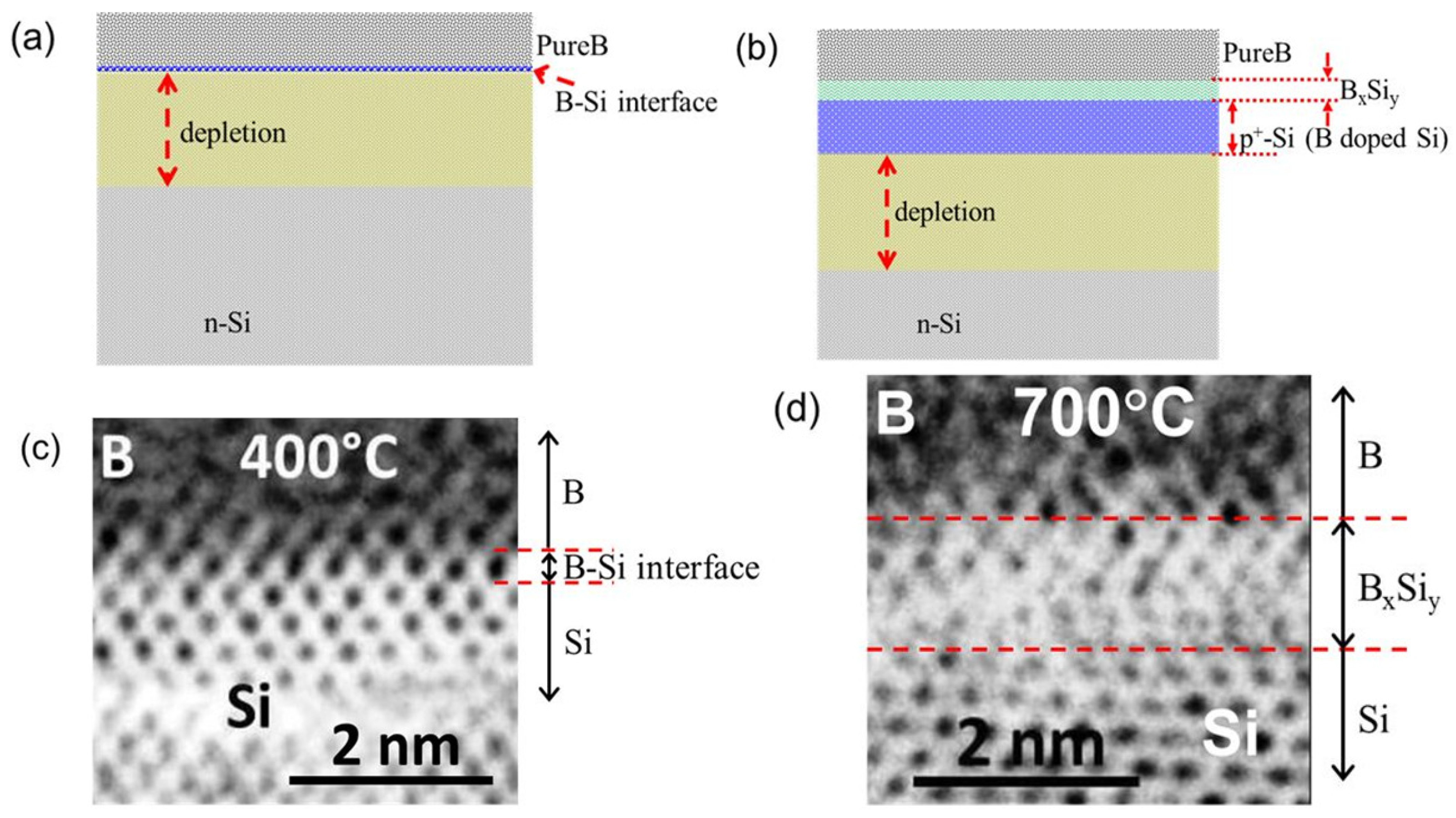


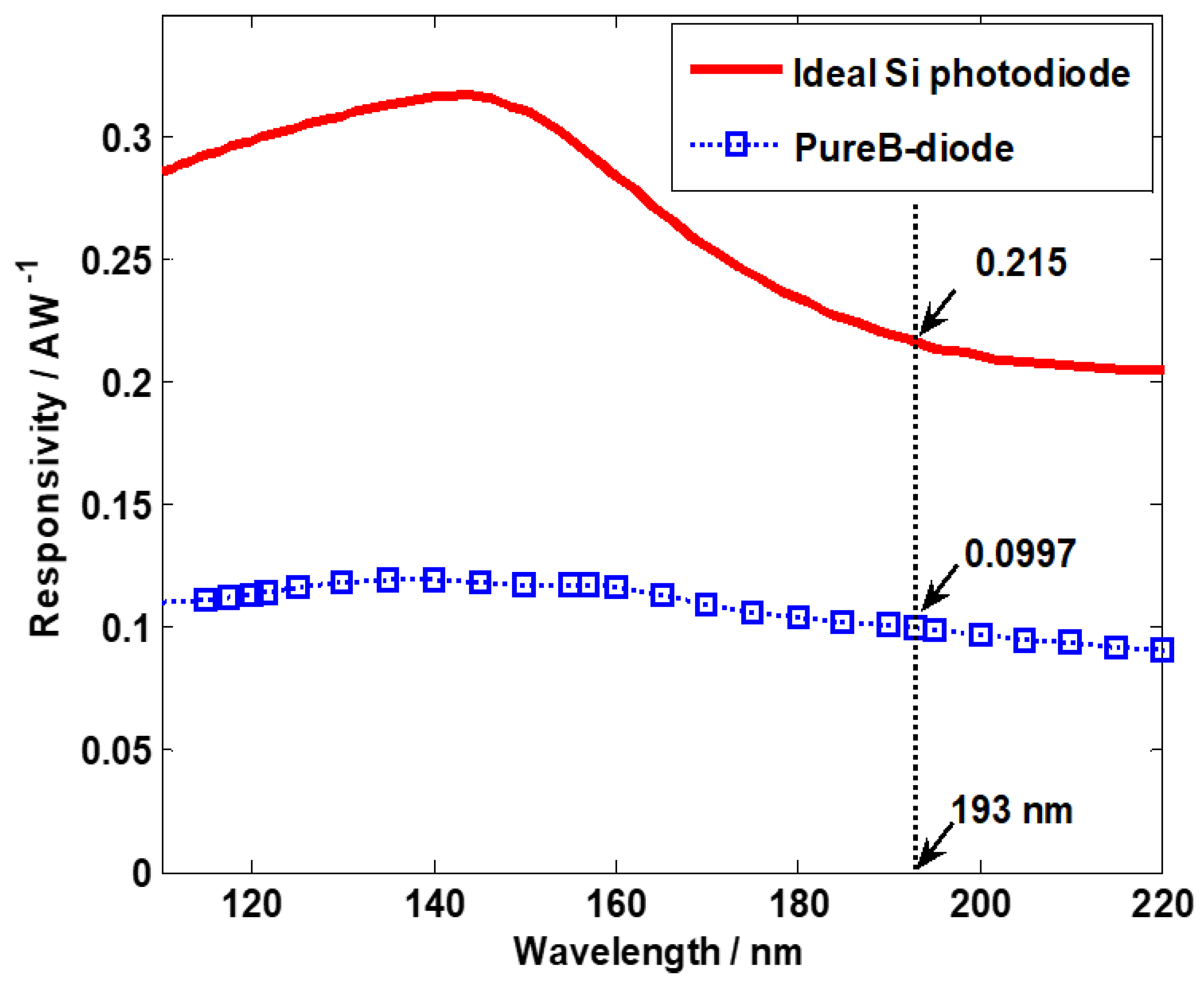
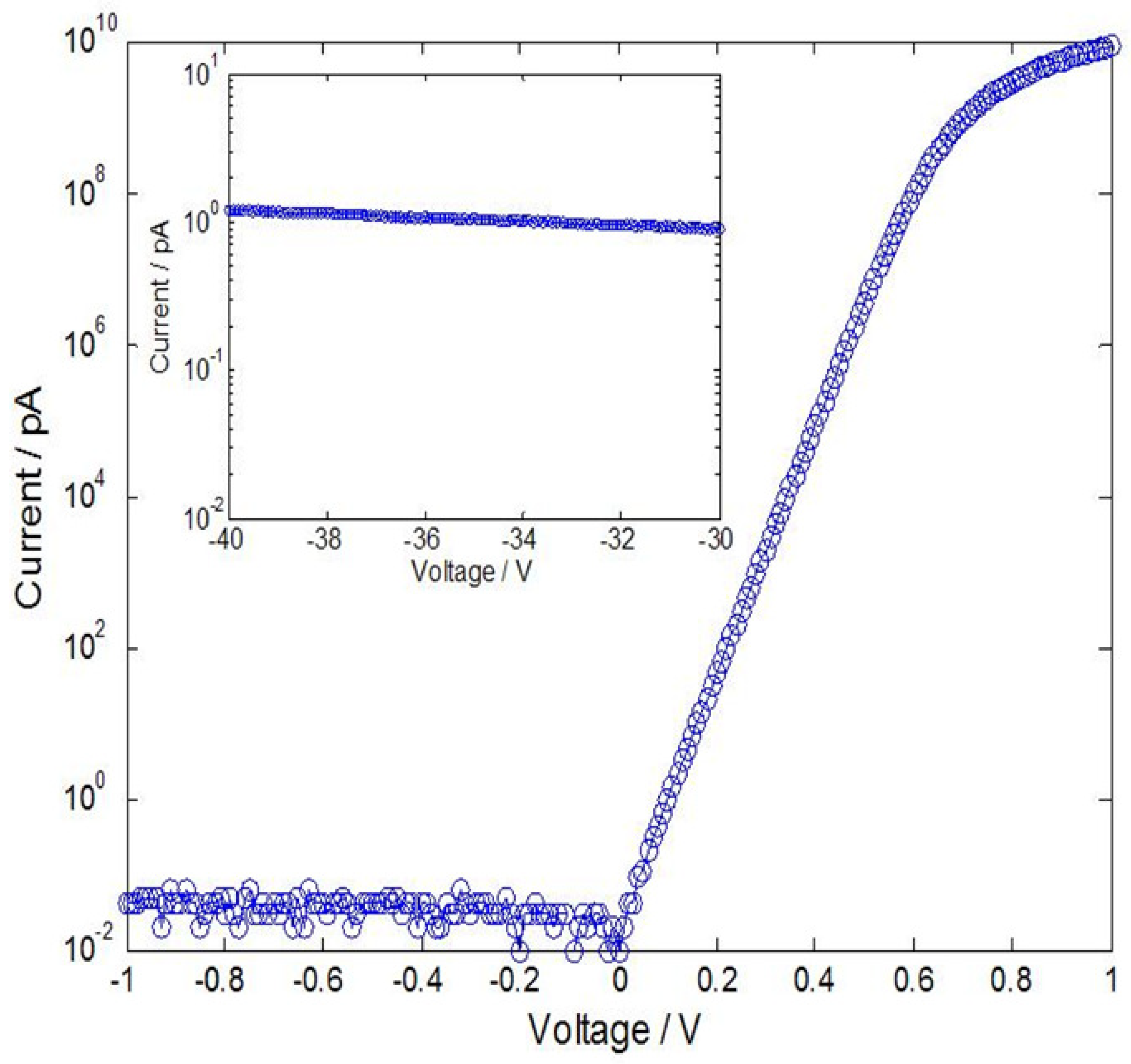
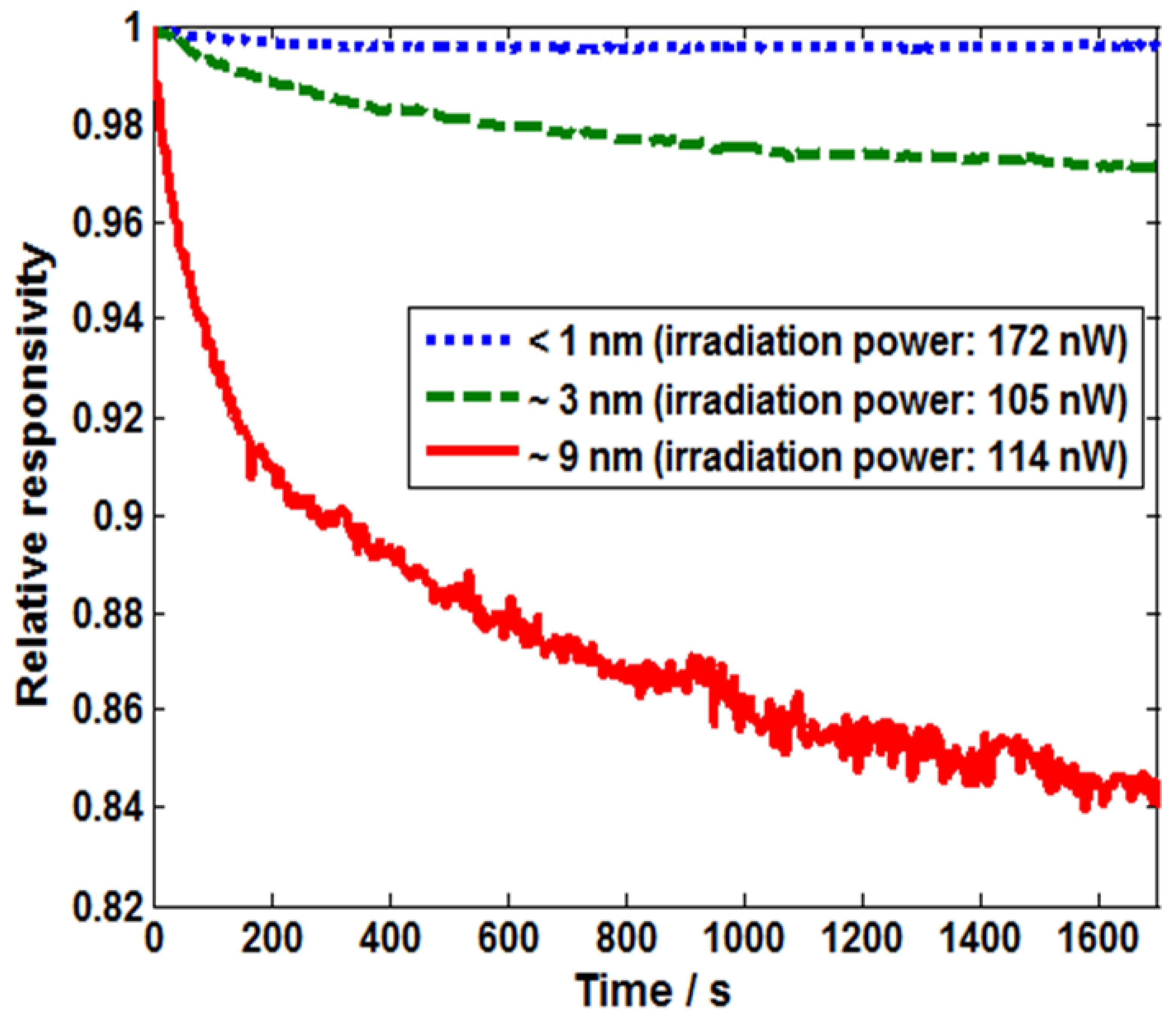

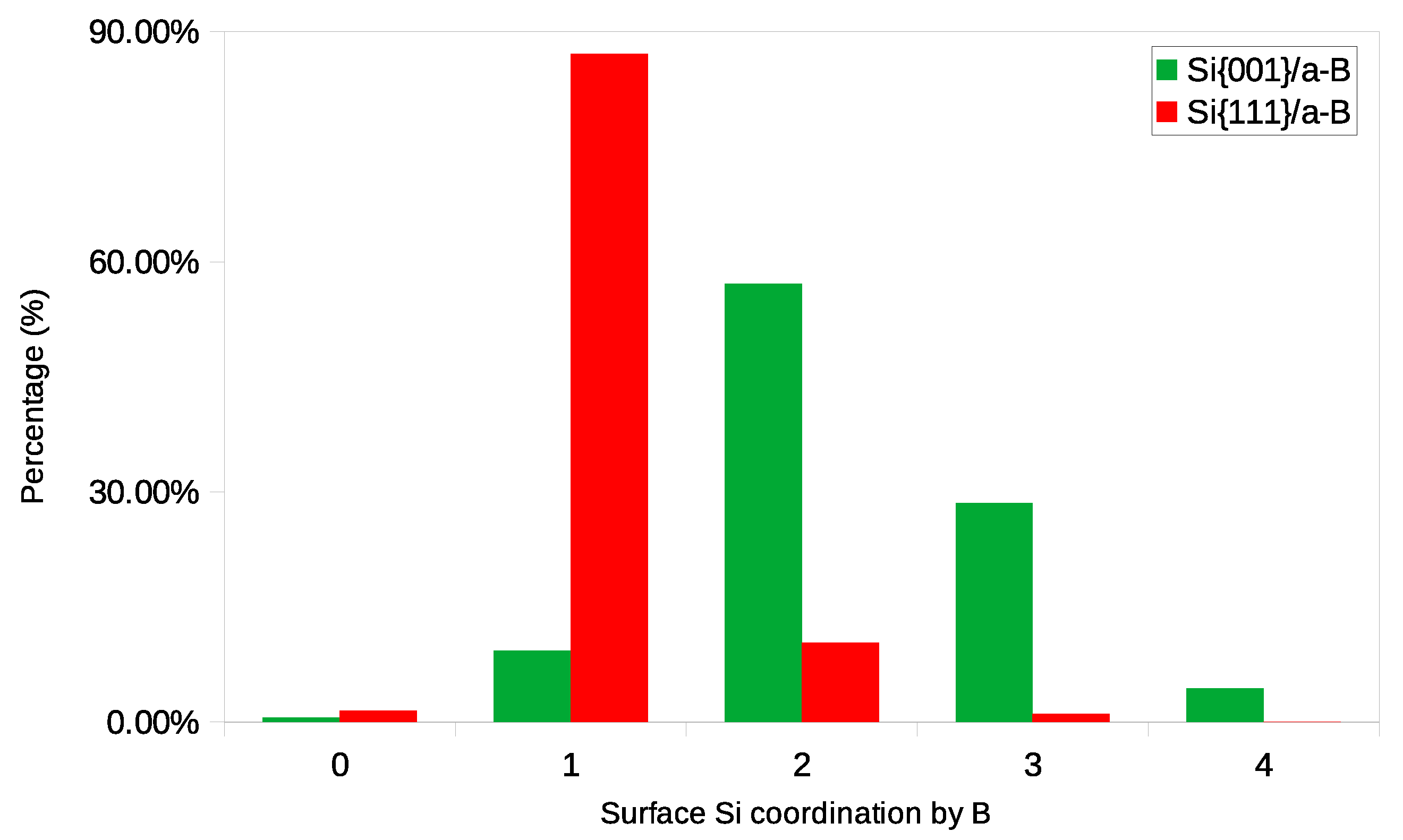
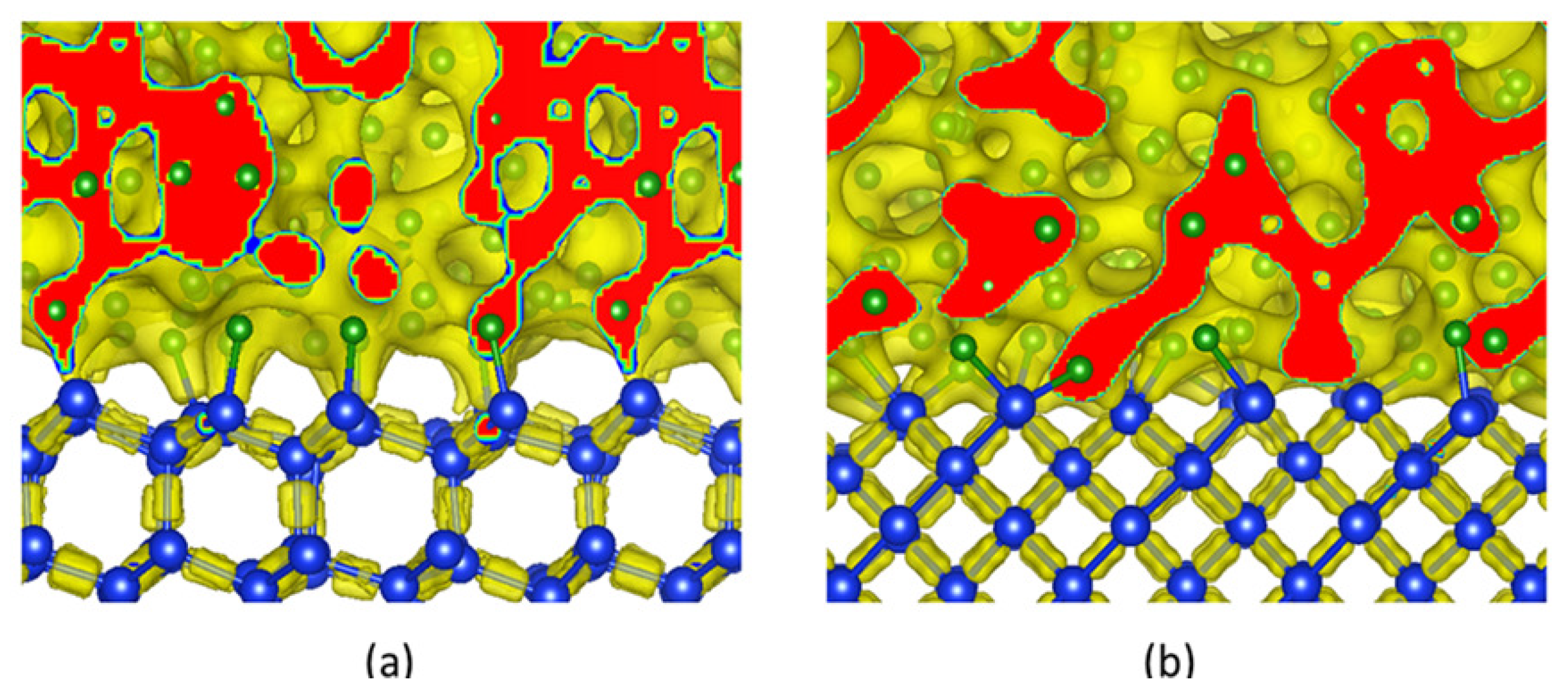
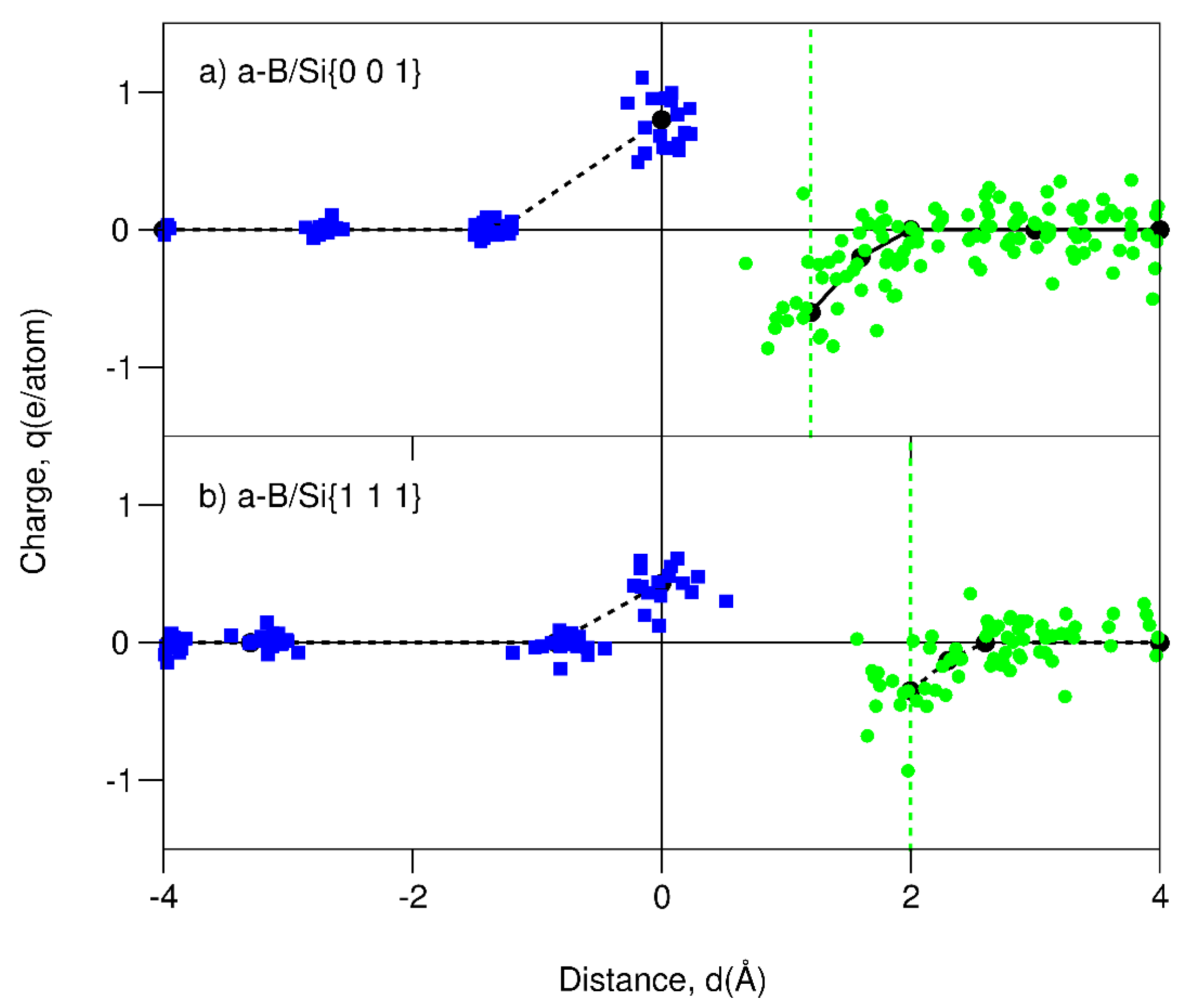
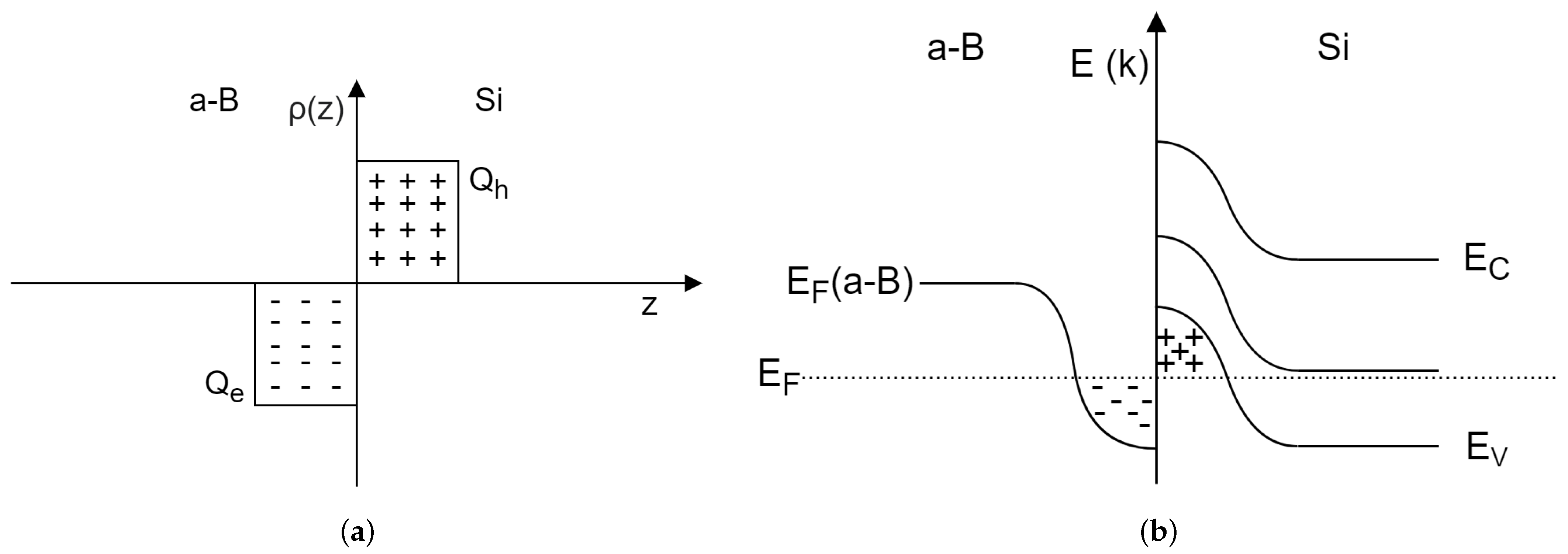
| Main Characteristics | Related Diode Parameters | Ideal Parameter Values |
|---|---|---|
| Responsivity | Passivation layer thickness | 0 |
| Depletion depth | 0 | |
| Depletion width | Optimized by the photon attenuation length | |
| Resolution | Dark current | 0 |
| Shunt resistance | ∞ | |
| Stability | Passivation Layer | Oxide-free, high-conductivity, protective |
| Operational speed | Series resistance | 0 |
| Junction capacitance | 0 |
Publisher’s Note: MDPI stays neutral with regard to jurisdictional claims in published maps and institutional affiliations. |
© 2021 by the authors. Licensee MDPI, Basel, Switzerland. This article is an open access article distributed under the terms and conditions of the Creative Commons Attribution (CC BY) license (http://creativecommons.org/licenses/by/4.0/).
Share and Cite
Sberna, P.; Fang, P.X.; Fang, C.; Nihtianov, S. Mechanism of Electronegativity Heterojunction of Nanometer Amorphous-Boron on Crystalline Silicon: An Overview. Crystals 2021, 11, 108. https://doi.org/10.3390/cryst11020108
Sberna P, Fang PX, Fang C, Nihtianov S. Mechanism of Electronegativity Heterojunction of Nanometer Amorphous-Boron on Crystalline Silicon: An Overview. Crystals. 2021; 11(2):108. https://doi.org/10.3390/cryst11020108
Chicago/Turabian StyleSberna, Paolo, Piet X. Fang, Changming Fang, and Stoyan Nihtianov. 2021. "Mechanism of Electronegativity Heterojunction of Nanometer Amorphous-Boron on Crystalline Silicon: An Overview" Crystals 11, no. 2: 108. https://doi.org/10.3390/cryst11020108
APA StyleSberna, P., Fang, P. X., Fang, C., & Nihtianov, S. (2021). Mechanism of Electronegativity Heterojunction of Nanometer Amorphous-Boron on Crystalline Silicon: An Overview. Crystals, 11(2), 108. https://doi.org/10.3390/cryst11020108







